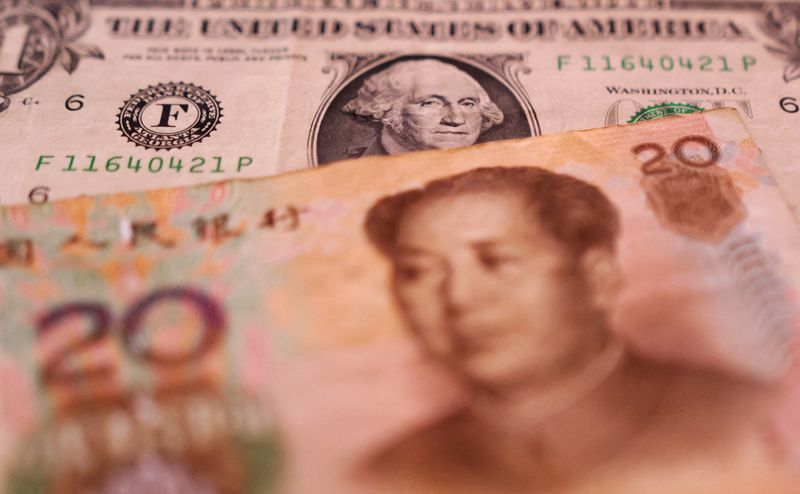By Sameer Manekar
(Reuters) – Analysts remained bullish on most Asian currencies despite marginally unwinding some bets, a Reuters poll showed on Thursday, as a defensive U.S. dollar driven by a dovish Federal Reserve boosted the appeal of risk-sensitive assets.
Long bets were highest on the Malaysian ringgit and Thai baht, with the latter at their highest since January 2023, driven by strong growth fundamentals and stabilizing politics.
Responses to the biweekly poll of 10 economists and analysts came before the US Federal Reserve’s half-point interest rate cut and Bank Indonesia’s surprise rate cut on Wednesday.
Anticipation of Fed rate cuts pushed the dollar on the defensive, giving emerging markets some much-needed breathing space and increasing their appeal. Most Asian currencies showed a great recovery against the dollar in August.
“We do not rule out further bouts of USD weakness in the coming weeks and expect general downward pressure on USD/Asia FX to continue,” Barclays analysts said.
The trend is around 100 against a basket of major currencies, down from 104 at the end of July.
The analysts said they expect Asian currencies to continue rising in the fourth quarter, but foresee a reversal in the first half of 2025.
Ryota Abe, an economist at Sumitomo Mitsui (NYSE:) Banking Corp, said the market’s view on Fed rate cuts by year-end “appears excessive,” which could lead to a correction in Asian emerging currencies markets.
Bullish bets on the Chinese yuan and Singapore dollar have returned to levels seen four weeks ago, while those on the Philippine peso reached a four-year high.
Analysts were long the Indonesian rupiah for the fourth consecutive time – the longest since May 2023 – underscoring recent appreciation driven by robust economic fundamentals and growing inflows into emerging markets.
The rupiah has appreciated by more than 6% since July and is expected to continue rising following Bank Indonesia’s (BI) surprise rate cut decision to support growth, with the Fed leading the way.
Barclays analysts said BI is “likely to be broadly equal to or slightly underperform the Fed in terms of the size of overall cuts,” which should not necessarily make the IDR worse from the Fed’s perspective interest rate differentials will fall out of favor with the markets.
The Indian rupee has remained out of favor with analysts, although short positions have halved since early August as the currency recovered from a sell-off following the expiration of carry trades in the yen.
The Asian currency positioning poll focuses on what analysts and fund managers believe are the current market positions in nine Asian emerging market currencies: the Chinese Yuan, the South Korean Won, the Singapore Dollar, the Indonesian Rupiah, the Taiwan Dollar , the Indian rupee, the Philippine peso, the Malaysian ringgit and the Thai baht.
The poll uses estimates of net long or short positions on a scale of minus 3 to plus 3. A score of plus 3 indicates that the market is significantly long in US dollars.
The figures include positions via non-deliverable forwards (NDFs).
Below are the survey results (US dollar positions versus each currency):
DATE
19-Sep-24 -0.67 -0.9 -1.12 -1.18 -0.66 0.33 -1.3 -1.1 -1.33
05-Sep-24 -0.85 -1.09 -1.26 -1.05 -0.77 0.21 -1.46 -1.00 -1.22
22-Aug-24 -0.62 -0.93 -1.08 -1.26 -0.70 0.21 -1.57 -1.03 -1.16
08-Aug-24 -0.02 0.05 -0.61 -0.02 0.59 0.60 -0.78 -0.29 -0.57
25-July-24 1.07 0.79 -0.33 0.35 0.86 0.12 0.39 0.43 0.02
11-Jul-24 1.05 0.87 0.06 0.73 0.68 0.22 1.03 0.86 0.51
27-Jun-24 1.34 1.28 0.80 1.49 0.88 0.46 1.00 1.37 0.91
13-Jun-24 0.95 0.87 0.62 1.22 0.64 0.37 1.00 1.23 0.92

30-May-24 1.05 0.72 0.33 0.94 0.53 0 0.81 1.19 1.00
16-May-24 1.05 0.96 0.35 0.96 1.02 0.39 1.23 1.29 1.00


